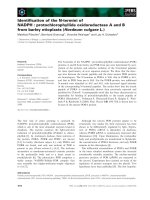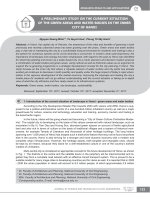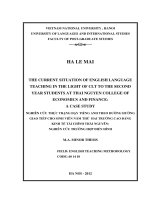The current situation of esp teaching at a technical university from teachers’ perspectives
Bạn đang xem bản rút gọn của tài liệu. Xem và tải ngay bản đầy đủ của tài liệu tại đây (224.96 KB, 3 trang )
Tuyển tập Hội nghị Khoa học thường niên năm 2019. ISBN: 978-604-82-2981-8
THE CURRENT SITUATION OF ESP TEACHING
AT A TECHNICAL UNIVERSITY
FROM TEACHERS’ PERSPECTIVES
Duong Thuy Huong
Hanoi University of Mining and Geology, email:
1. INTRODUCTION
English for Specific Purposes (ESP) has
recently attracted language researchers’
attention due to the requirements of workplaces
and the society. ESP is a learner-centered
approach whose purpose is to fulfill the
specific needs of target learners to satisfy either
their professional or vocational demands. At
present, ESP is either a compulsory or an
optional subject at technical universities in
Vietnam, which aims to help their students to
be well-equipped with specific language in
their working contexts and professional skills
after graduation. However, the teaching of ESP
are interpreted differently among universities,
leaders, teachers as well as students. These
stakeholders’ perspectives on ESP play a
decisive role in designing and implementing
ESP courses at university. Considering the
above mentioned issue in ESP implementation,
the paper tries to identify the current situation
of ESP teaching at a technical university in
Vietnam from teachers’ perspectives. The
findings will be precious data which help
leaders and managers at universities to have an
insight into the roles of ESP for the university.
Therefore, they contribute to making teaching
and learning ESP activities more advantageous
and practical in association with the
university’s context and close to the
workplace’s requirements.
2. METHODOLOGY
The paper uses document analysis and
interview with teachers to identify the current
state of teaching ESP at a technical university.
Interviews were conducted with 3 ESP
teachers from different faculties who have
been teaching ESP for more than 5 years. The
interview questions focus on their classrooms’
current situation, activities, challenges and
their viewpoints.
Interviews were also
carried out with 2 leaders from 2 faculties
which have a dominant number of ESP
subjects and one of them is also in charge of
the Training Curriculum; Information, data on
document
analysis
and
synthesis;
requirements from workplaces, ideas and
comments from graduates were also noted to
make the findings more valid and reliable.
3. LITERATURE REVIEW
ESP (English for Specific Purposes)
consists of teaching and learning the specific
skills and language needed by particular
learners for a specific purpose. Hutchinson &
Waters (1987) defined ESP as an approach to
language teaching in which all decisions as to
content and method are based on the learners’
reason for learning. The definition given by
Johns and Dudley‐Evan (1991) suggests
that ESP is proved to be a permissive,
flexible field of study, having influenced the
entire process of English teaching.
English is a language; therefore, the
teaching should focus on cultivating students’
ability of applying English. ESP follows this
principle which refers to a specific profession
or related disciplines, setting up English
courses according to the learner’s particular
691
Tuyển tập Hội nghị Khoa học thường niên năm 2019. ISBN: 978-604-82-2981-8
purpose or the specific need. However, it
reveals an enormous gap between higher
education provision and industry needs. That
is why employers find it hard to employ
graduates with appropriate knowledge and
skills to fulfill their job’s requirement. This
problem can be caused by factors related to
teachers, materials, teaching methods,
testing, curriculum and even policies from
universities and Vietnamese Ministry of
Education and Training. There are no specific
policies to raise the level of ESP teaching;
there is a serious lack of stable professional
ESP teachers; the ESP courses are
undertaken by non-English major teachers
whose English level is not high and the
teaching method is not appropriate, which
kills the students’ interest and confidence in
learning English. (Bingyao, 2016). The
problems also appear in the curriculum which
put the focus on teaching GE for students at a
certain level since the leaders think that they
can change from General English (GE) to
ESP without any difficulties. And instead of
making real analysis on ESP stakeholder’s
needs, ESP teachers become slaves of
published textbooks without analyzing their
appropriateness for the ESP course.
4. CURRENT SITUATION OF TEACHING
ESP AT A TECHNICAL UNIVERSITY
4.1. ESP syllabus design
The University under study has 9 majored
faculties with 29 different ESP subjects
conducted by content teachers. Todate, they
have used fifty-six different ESP textbooks,
25 of which are published abroad and 31 are
published domestically and implemented
internally. Of the 31 ESP textbooks designed
by content teachers, 21 include reading
passages with a list of new words and 5 to 10
questions at the end of each lesson. The rest
10 ESP textbooks give some more exercises
in vocabulary, translation and summary, only
2 textbooks mention listening and speaking
skills. (Duong, 2017).
In 2006, the Training Curriculum changed
from school year to credit system, the hours
for ESP subjects were cut down from 75 hours
to 45 hours (3 credits) or 30 hours (2 credits);
from 300 hours to 90 hours for General
English. (Duong, 2017). All 3 ESP teachers
admitted that the duration for ESP is too short,
“It seems like a quick walk or a very brief
introduction into ESP” (Teacher 2); “We need
more time for the subject so we can introduce
academic studies and ESP with their future
jobs” (Teacher 3). “We teach 2 hours weekly
in 15 weeks, students even do not remember
what they studied the next week and they have
to study several subjects at the same time. We
need more time to fulfill the outcomes of the
ESP course”. (Teacher 1). The interviewed
leaders admitted that there is no official policy
for ESP at the university and each faculty
designs and develops their own ESP syllabus
based on the Training Curriculum Framework
by the university. “The faculties build their
own training majors in which ESP is either an
optional or a compulsory subject. They will
choose the number of credits for each subject
to fulfill the outcomes requirements of the
training major” (Leader 2). As a result, the
number of credits for ESP (and some other
subjects) must be reduced and its outcomes of
equipping students with knowledge, workrelated skills are hard to achieve.
4.2. Teachers and teaching methodology
ESP teachers at the university are also
content teachers from different majored
faculties. The procedure of the ESP lesson
described by teachers seems to be typical, more
“lecture-centered” than “learner-centered”.
They also believed that terminologies and
translation are the most important in teaching
ESP for technical students, which is thought to
achieve the outcome purpose and suitable to
the very short course like ESP. “We want
students to be able to read specialized
documents in English, which can help them in
doing research for higher study”. (Teacher 3);
Such perception, to some extent makes the
lessons less interesting and students passive
and demotivated in ESP lessons.
692
Tuyển tập Hội nghị Khoa học thường niên năm 2019. ISBN: 978-604-82-2981-8
In terms of methodology, all interviewed
teachers have never attended a course for
ESP teachers, which explains the difference
in methodology between ESP and language
teachers at the university. For the nature and
objectives of ESP pedagogy, it has been
proved that language teachers are more
suitable for ESP teaching than teachers of
subject knowledge because teaching ESP is
in fact teaching languages. (Tabatabaei,
2007). Therefore, the content teachers’
teaching methods are not appropriate, not
innovative. The teachers change the ESP
courses abruptly into translation courses and
bilingual courses which may kill the
students’ interest and confidence in learning
English and it is difficult for the teachers to
persuade the students of the importance of
ESP for their future’s job.
4.3. ESP learners
According to ESP teachers, only some
students are interested in the lessons and the
majority feel demotivated. The main reason
is because of students’ low level in General
English. “Students’ attention was not high.
They showed their interest at first then lost it
after 30 minutes. It maybe because they were
lazy and found the lessons difficult with lots
of new words”. (Teacher 2); “Students’
competence in English is too low; therefore,
only some students who are good at English
participate in the classroom activities”.
(Teacher 3). Besides, problems of
heterogeneity in language proficiency, low
levels of general proficiency, lack of
motivation and passive learning style are also
mentioned as problems in ESP teaching.
4.4. Teaching ESP at the university
versus workplace’s requirements
The requirements from workplace in using
English in working environment seem
mismatch with the way ESP is being
implemented at the university. The outcomes
of ESP course focus on reading and
translation while working environment
requires a variety of skills such as writing
email, processing technical issues, reading
and writing reports, working with foreign
partners. “We have to retrain both major and
ESP and organize short courses in ESP so
that the new employees get used to the job
and be able to get work done”. (Graduate 1).
5. CONCLUSION
ESP teaching at technical universities is
still a controversial issue which should be
paid more attention by policy makers and
leaders. Problems in ESP teaching from
teachers’ perspective are an important
channel for them to make right and wise
decisions which help to align with society’s
requirements. Both solid professional
knowledge and English application ability are
favorite in the job market. The employers are
more humanized to graduates’ foreign
language ability. ESP teaching is imperative.
It should be made “the students as the main
learners, teachers as the leading” throughout
the higher vocational English teaching. At the
same time, they also need to integrate into the
international education and step into the
future together. (Bingyao, 2016).
6. REFERENCES
[1] Bingyao, H. (2016). A Brief Introduction on
ESP Teaching Current Situation and the
Countermeasures in Higher Vocational
Colleges. Higher Education of Social
Science, 10(4), 5-8.
[2] Duong, T.H. (2017). Dạy và học tiếng Anh
chuyên ngành tại Trường Đại học Mỏ- địa
chất: Thực trạng và giải pháp. Graduate
Research Symposium (GRS), Ulis.
[3] Hutchinson, T. and A. Waters (1987).
English for specific purposes. Cambridge
University Press.
[4] Johns, A. M., & Dudley‐Evan, T. (1991).
English for specific purposes: International
in scope, specific in purpose. TESOL
quarterly, 25(2), 297-314.
[5] Tabatabaei, O. (2007). Who qualifies to
monitor an ESP course: a content teacher or
a language teacher? Indian Journal of
Applied Linguistics, 33(1), 77-86.
693









